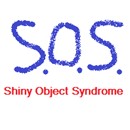Monday Author: Susanne Skinner
 Shiny Object Syndrome is the disease of distraction and it’s real. There is no official diagnosis and it isn’t fatal, but if you have it your life is defined by the lure of Bright Shiny Objects. The most damning characteristic is enthusiastically starting projects but never finishing them, despite heroic efforts to follow through. Like a gym membership that never gets used or a series of fantastic business plans that don’t result in an actual program or real product.
Shiny Object Syndrome is the disease of distraction and it’s real. There is no official diagnosis and it isn’t fatal, but if you have it your life is defined by the lure of Bright Shiny Objects. The most damning characteristic is enthusiastically starting projects but never finishing them, despite heroic efforts to follow through. Like a gym membership that never gets used or a series of fantastic business plans that don’t result in an actual program or real product.
People have it, and so do businesses run by people who have it. Shiny Object Syndrome is the attraction to anything with a real or imagined glassy, polished, or shiny appearance. It can be an actual item, but more likely it’s a concept without enough focus and commitment to ever become a reality.
When the idea’s newness and shininess wear off, so does the interest and it’s time to look for a newer, shinier object to replace the one that is unrealized and fading away.
The Starting Spiral
Great energy and excitement are intrinsic to starting something new, but SOS sufferers are unable to finish what they start in spite of their enthusiasm and credible skill set. Faced with completing a project, task, or even running a company, they are overcome with the inability to focus and make decisions. Without forward momentum nothing gets accomplished and time and money are wasted in the process.
 It’s not a lack of ideas that causes this, but too many vague ideas about making something bigger, better or cheaper with no clear thought to the process of actually doing it.
It’s not a lack of ideas that causes this, but too many vague ideas about making something bigger, better or cheaper with no clear thought to the process of actually doing it.
Those with SOS get caught up in the starting spiral: Start. Start Over. Start Again. Keep Starting. This inability to get past the starting line is filled with self-doubt, indecision, and fear of actually moving in a forward direction. Shiny objects cloud peripheral vision until they become distracting enough to shift the focus in their direction.
Making a decision comes with accountability and the risk of making a wrong decision. When victims of SOS are stuck in the spiral, they tend to focus on the novelty of their idea rather than the actual creation and execution of the strategy.
Failure to make decisions is followed by procrastination, followed by guilt about procrastinating, followed by even more procrastination and guilt.
Results Come from Hard Work
The only way to overcome Shiny Object Syndrome is to actually do what you say you want to do. That sounds easy, but starting a new project requires due diligence and a set of clear, actionable plans in order to see meaningful results. It means focusing on something specific with checkpoints to chart progress and make corrections.
Without a long-term plan, abandonment is practically guaranteed. When the work gets too hard it’s easier to shift focus and find a new shinier opportunity. The work feels too hard because there is no way to measure success against a plan you didn’t create.
When Shiny Object Syndrome Gets Personal
Shiny Object Syndrome is also personal. Trying to improve or change any aspect of your life can feel overwhelming. Changing jobs, losing weight, overcoming a fear, or learning a new skill means working hard for the results you want to see.
Let’s talk about weight loss, because that’s personal to me and I know the distractions all too well. I’ve done it before—it is hard—and I’m working on it again. Distractions come in the form of carbohydrates and the belief that even though I put the weight on one pound at a time it’s magically coming off in five-pound blocks.
I gained it back when I stopped measuring my success against the plan I created. I learned the nutritional value of foods and how to track them, added exercise into each day with a goal I measured against my effort to lose the weight.
I belong to Weight Watchers. Part of my plan includes other people on the same journey to hold me accountable and keep me inspired. If I did not have that support system, abandoning the goal would be all too easy.
Oh Look, There’s a Squirrel!
Everyone gets distracted – we’re human. Differentiating between shiny objects and what is real is not always clear cut. Distractions are internal as well as external, so while we are paying attention to what is on the outside, we must also tune in to ourselves. If there is no balance on the inside, external distractions are even greater.
 I recommend making a list of what you want to do with a completion date. Write down when it needs to be done. Find something on the list that energizes you and visualize what it looks like when you complete it; documenting realistic milestones for success.
I recommend making a list of what you want to do with a completion date. Write down when it needs to be done. Find something on the list that energizes you and visualize what it looks like when you complete it; documenting realistic milestones for success.
Your brain needs a process it can follow. If you can’t visualize the results, wait. Learn to focus; think it through until it clarifies, then decide what value it adds and at what cost. Know when to say no.
Balance and Focus
Shiny Objects are everywhere. Balance what you know about yourself and the project you are considering against the evidence around you. Stay focused on the outcome, learn from past experiences and aim for realistic results. Remember that shiny does not always equal valuable.
